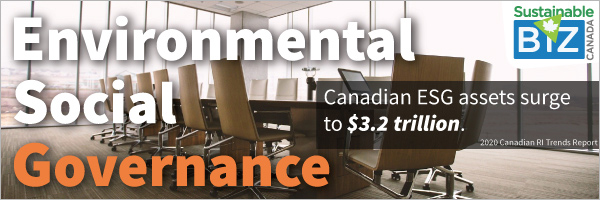Recent Articles
Real estate sector making up for lost time on ESG front
Real estate sector making up for lost time on ESG front
The real estate industry has been late to join the ESG (environmental, social, and governance) movement but is adapting quickly and is making changes that will be transformational to the sector.
Activist hedge funds joins fight against climate change
One of the most expensive Wall Street shareholder battles on record could signal a big shift in how hedge funds and other investors view sustainability. In a vote, Exxon shareholders approved board members nominated by hedge fund, Engine No. 1, dealing a major blow to the oil company.
Warming planet reforms way banks define risk
Banks may soon face capital requirements reflecting how exposed their loan books are to climate change. The goal is to force banks to channel money away from polluters toward businesses that are committed to lowering carbon emissions.
Canada faces problem as cleantech funding flows
Demand for sustainable investments has led to record funding for early-stage companies in Canada’s cleantech venture capital firm. The money spotlights the struggle to keep homegrown innovations within its borders before companies become major employers.
The rise of CO2 as feedstock
Would you drink beverages made with carbon dioxide captured from the smokestack of a factory or power plant? Carbon capture and utilization is the process of capturing CO2 to be recycled into products such as plastics, concrete, and carbonated drinks.
GoC and CAC create low-carbon concrete
• Canada Newswire • Daily Commercial News
A joint statement by the Government of Canada and the Cement Association of Canada introduced a roadmap to net-zero carbon concrete. This roadmap will position Canada’s cement and concrete industry to become a global leader in low-carbon concrete production.
New building techniques lessen carbon footprint
The role buildings play in our cities is becoming increasingly significant in our mission to lessen our carbon footprint and contribute to a better planet. New techniques and technologies are fostering the well-being of buildings and the people inside them.
Skanska tests reuse precast concrete
Concrete remains a barrier to climate-friendly buildings and is responsible for at least 7 per cent of carbon emissions worldwide. Skanska is conducting tests on a condemned building in Finland to discover how used concrete can be reused in new buildings.
Ontario loses farmland to urban development
• CBC
Over the past two decades, Ontario lost farmland at a rate of 175 acres (about 70 hectares) a day, the equivalent of five family farms each week, according to a recent analysis of census data from the Ontario Federation of Agriculture (OFA).
Taza puts sustainable design at forefront
Taza is the largest First Nation development in Canada, located in Calgary, Alberta. The project is actively putting sustainable practices at the forefront of its design and building guidelines. This includes honouring and respecting the land based on Tsuut’ina culture.
Saint-Laurent awarded for biodiversity corridor
The Canadian Society of Landscape Architects (CSLA) awarded Saint-Laurent the Award of Excellence for its biodiversity corridor. The project also won an award granted by the Royal Architectural Institute of Canada, the Canadian Institute of Planners, and the CSLA.
Addressing challenges of microgrid systems
A centralized grid delivers electricity to 145 million U.S. customers. That energy system is becoming more complex due to distributed energy resources, especially nature-driven wind and solar PV in place of fuel-powered generators, which complicate voltage maintenance and frequency stability.
Electric vehicles and the electric grid obstacle
In the accelerating push to electrify transportation, one big obstacle always comes up: The grid. How will the electrical grid handle so many vehicles charging at once? Especially when fast-charging stations gulp down prodigious amounts of power?
EV charger installation contingent on funding
The Toronto Atmospheric Fund (TAF) could disburse grants to install 300 EV chargers in public venues and residential buildings throughout the Greater Toronto and Hamilton Area (GTHA). This is contingent on Toronto Council’s approval for $2 million in funding from ZEVIP.
Limited charging stations deter EV sales
With the increasing presence of electric vehicles, EVBox Group, a provider of charging stations, conducted two studies—one in the U.S. and the other in six European countries—to get a better understanding of the current market for electric driving.
5 electric bus makers shifting into next gear
• GreenBiz • Sustainable Biz Canada
The transportation sector is responsible for nearly one-quarter of global energy-related CO2 emissions, according to the United Nations. Delivering transport options for communities and minimizing tailpipe emissions means piecing together a puzzle including infrastructure needs, regulatory compliance, and trend forecasts.
Hines building $200M timber tower in Australia
Global investment manager Hines will begin construction of a $200 million timber office tower in Australia in the second half of the year, confident it can secure tenants seeking more affordable premises in a new building designed for the post-COVID age.
New tech meets ancient material in 3D-printed home
Using the earth as a building material is one of the world’s oldest techniques, with some examples dating back at least 10,000 years in North Africa. New technologies have evolved construction techniques, most notably with the recent advent of 3D printing.
Brookfield explores sale of biofuel provider Greenergy
Brookfield Business Partners is weighing a sale of U.K.-based biofuel provider Greenergy. The U.S.-listed investment firm is working with Citigroup and HSBC to gauge interest in Greenergy from potential suitors, asking not to be identified discussing confidential information.
India, UK collaborate on green hydrogen
• H2 View
India and the UK will strengthen its partnership on climate change to reduce carbon emissions by the end of the current decade. The collaboration on green hydrogen will include sharing useful knowledge, policy and regulatory cooperation, research, and innovation.
Nemaska Lithium achieves a key strategic milestone by securing a chemical conversion facility site at the Industrial Park and Port of Bécancour
Nemaska Lithium Inc. (“Nemaska Lithium” or “Company”) announces that it has entered into an option agreement to purchase a 500,000m² plot of land in the Industrial park and port of Bécancour (“Bécancour”) to construct and operate its chemical conversion facility (“Conversion Facility”). The Conversion Facility will form part of an integrated project to market solution with Nemaska Lithium’s Whabouchi mine to produce battery grade lithium hydroxide.
 Industry Events
Industry Events
-
Microgrid Knowledge (MGK) Conference 2024
Apr 22 2024
to Apr 24 2024
Baltimore, Maryland
-
Canada Green Building Council: Building Lasting Change 2024
Jun 05 2024
to Jun 06 2024
Toronto
-
Global Conference on Renewable Energy and Environmental Sustainability
Aug 16 2024
to Aug 18 2024
Vancouver, Canada











